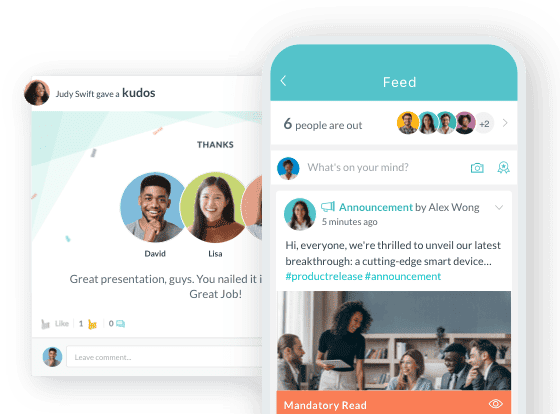Best Employee Recognition Software for Healthcare Organizations in 2025: Why HR Cloud's Workmates Leads
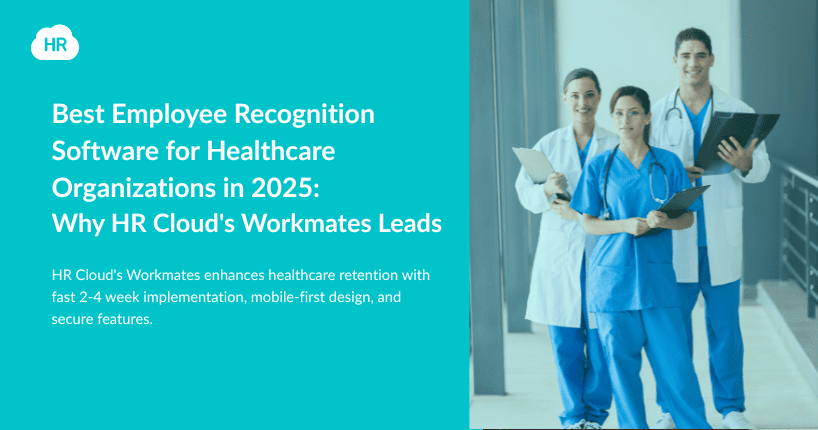
- Why Is Employee Recognition Non-Negotiable in Healthcare Settings?
- What Makes Healthcare Recognition Software Different from Generic Platforms?
- Which Recognition Platforms Lead the Healthcare Market in 2025?
- ROI Healthcare Organizations Should Expect from Recognition Software
- Implementation Strategy for Healthcare Environments
- Conclusion: Choose Recognition Software That Actually Works in Healthcare
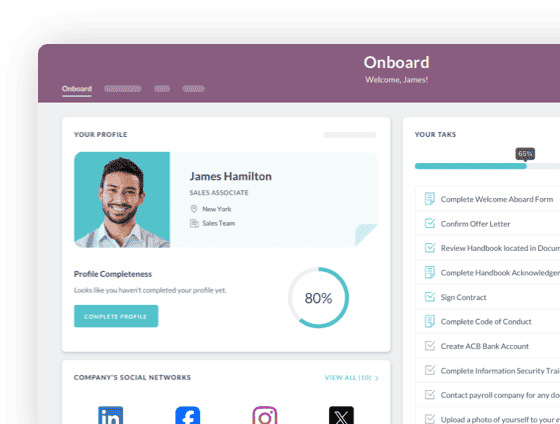
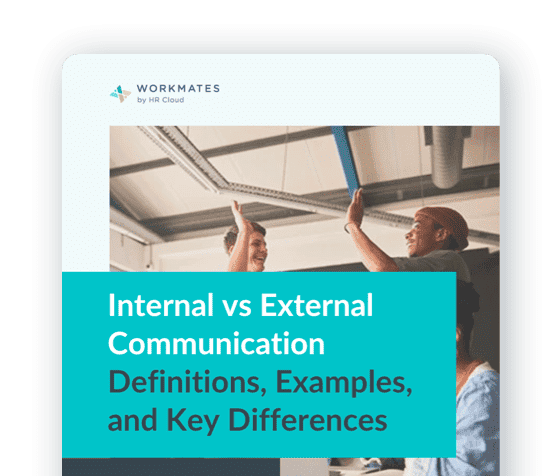
 Cut onboarding time
by 60%—here's the
Ultimate Checklist
that helped do it.
Cut onboarding time
by 60%—here's the
Ultimate Checklist
that helped do it.
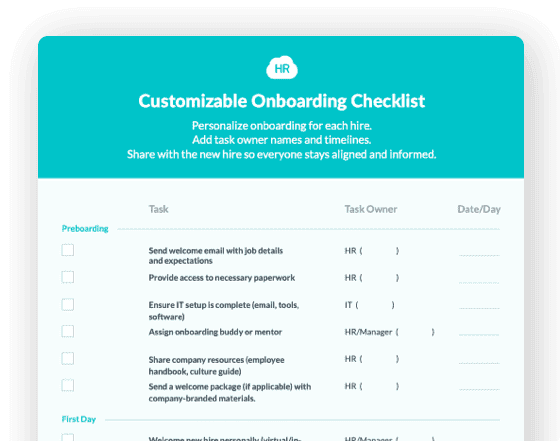
Healthcare organizations face turnover rates averaging 16.4% for RNs, with each departure costing $61,110. The right employee recognition software can reduce voluntary turnover by 31% while improving patient safety outcomes. This guide compares leading platforms for healthcare-specific recognition needs. HR Cloud's Workmates emerges as the clear winner with comprehensive engagement features, healthcare-focused design, proven retention impact, and 2-4 week implementation—dramatically faster than competitors requiring months of deployment.
Introduction
Picture this: It's 2:00 AM in the cardiac intensive care unit. Sarah, a veteran nurse with twelve years at the hospital, just caught a critical medication error that could have cost a patient's life. Her quick thinking saved someone's child, someone's parent. But when morning rounds happen, nobody mentions it. No acknowledgment, no recognition—just the same grind waiting tomorrow night.
Three weeks later, Sarah accepts a position at a competitor. Her exit interview reveals what healthcare organizations hear repeatedly: "I just didn't feel valued."
The industry's turnover rate decreased to 16.4% for registered nurses, but the financial impact continues climbing. Each RN departure now costs an average of $61,110, pushing the typical hospital's annual turnover expenses between $6.6 million and $10.5 million. Departments like emergency services experience cumulative five-year turnover rates exceeding 113%—essentially replacing their entire staff in under four and a half years.
But here's what matters more: healthcare organizations with highly engaged employees experienced 41% fewer patient safety incidents compared to those with disengaged workforces. When nurses feel appreciated, everyone benefits—from accountants to the patients receiving life-saving care.
This guide examines the best employee recognition software platforms specifically designed for healthcare organizations in 2025. You'll discover what distinguishes healthcare-appropriate solutions from generic recognition tools, compare leading vendors, and understand why HR Cloud's Workmates platform has emerged as the top choice for medical facilities navigating complex compliance requirements while building cultures where clinical staff genuinely want to stay.
Key Takeaways
-
Healthcare turnover carries massive financial consequences: The average cost to replace one staff RN reached $61,110 in 2025, with most hospitals losing between $6.6M-$10.5M annually to turnover
-
Recognition directly impacts retention rates: Organizations with strong recognition programs see 31% lower voluntary turnover and 45% better two-year retention compared to companies with weak appreciation cultures
-
Healthcare requires specialized recognition features: Secure data handling, mobile-first design for frontline workers, shift-based recognition, and integration with scheduling systems aren't optional—they're essential.
-
Patient outcomes improve with engaged staff: Healthcare facilities with highly engaged employees experience 41% fewer patient safety incidents and measurably better quality metrics
-
Implementation speed separates leaders from laggards: HR Cloud's 2-4 week deployment crushes competitors requiring 8-12 weeks, reducing change fatigue and accelerating ROI
-
Recognition extends beyond nurses: Comprehensive platforms celebrate CNAs, environmental services, administrative staff, and everyone contributing to patient care
-
Mobile accessibility isn't negotiable: With 70% of healthcare workers spending limited time at computers, recognition systems must work seamlessly on smartphones
Why is Employee Recognition Non-Negotiable in Healthcare Settings?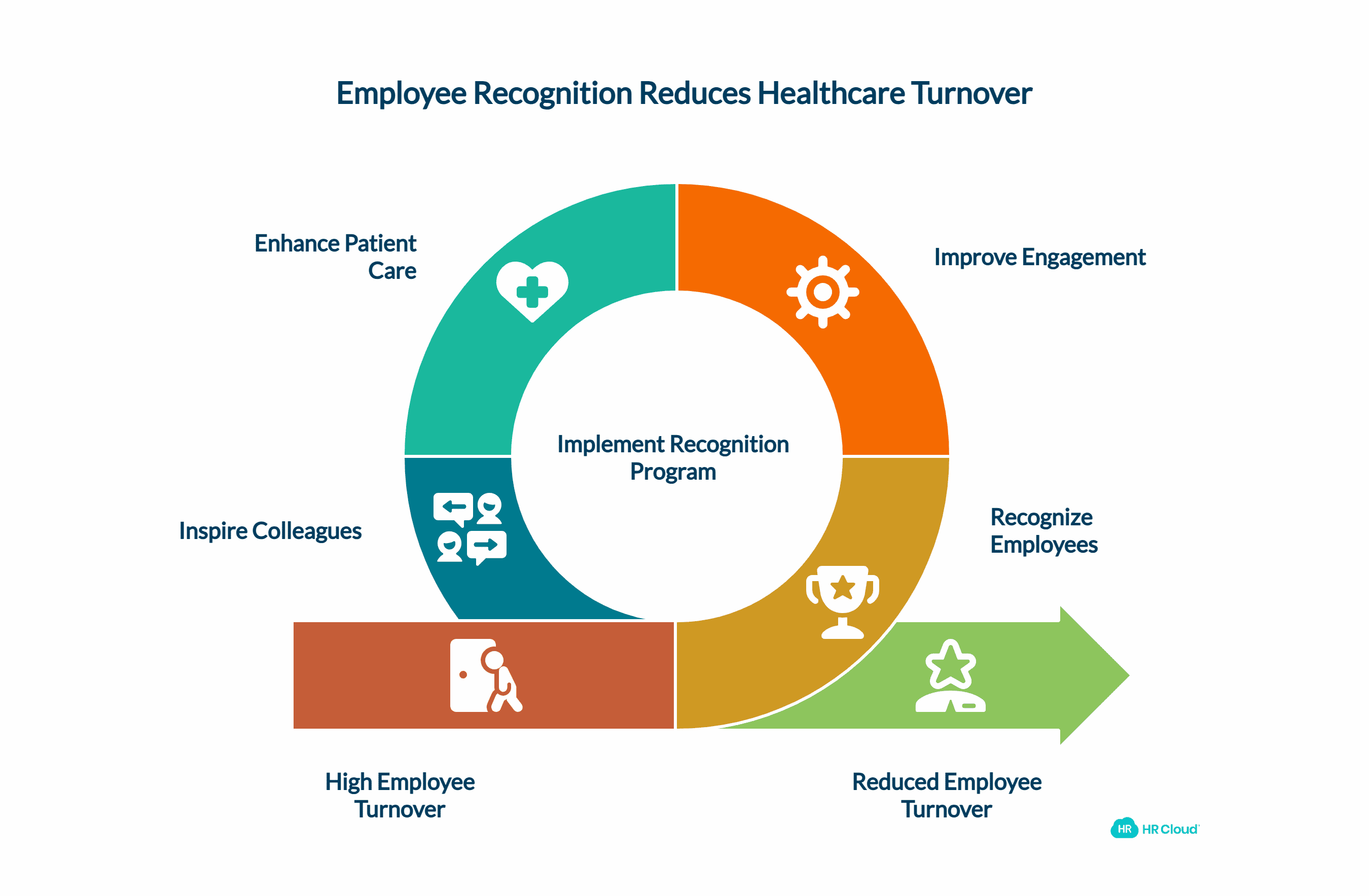
Walk through any hospital at 3:00 PM and you'll witness organized chaos. Nurses rushing between patient rooms. Respiratory therapists managing ventilators. Environmental services staff sanitizing rooms. Everyone moving with purpose, everyone carrying responsibility that literally determines whether patients live or die.
When's the last time anyone received genuine recognition for the extraordinary work they do every single day?
The Financial Reality CFOs Can't Ignore
According to the 2025 NSI National Health Care Retention & RN Staffing Report, hospitals continue operating at an 18.3% overall turnover rate. Nearly one in five healthcare workers leaves annually. For certain high-stress departments, some emergency departments and telemetry units lose their entire nursing staff every three to four years.
A 200-bed hospital losing 30 nurses annually burns through $1.83 million just on RN turnover. Add turnover among CNAs, techs, and other roles, and you're easily approaching $3 million in preventable costs. What could your organization do with an extra $2 million? Upgrade equipment? Expand services? The resources exist—they're currently being wasted on recruiting and replacing people who didn't need to leave.
Recognition as Preventive Medicine for Turnover
Research from Gallup and Workhuman demonstrates that well-recognized employees are 45% less likely to leave after two years. Organizations implementing comprehensive recognition programs see voluntary turnover drop by 31%.
If recognition software could help your hospital retain just five additional nurses annually, you'd save over $305,000—likely more than the total cost of the recognition platform itself. And that's before factoring in improved patient outcomes, reduced safety incidents, or better team morale.
Recognition doesn't just prevent the worst-case scenario. It creates a positive feedback loop where appreciated staff become more engaged, deliver better patient care, and inspire colleagues to do the same.
What Makes Healthcare Recognition Software Different from Generic Platforms?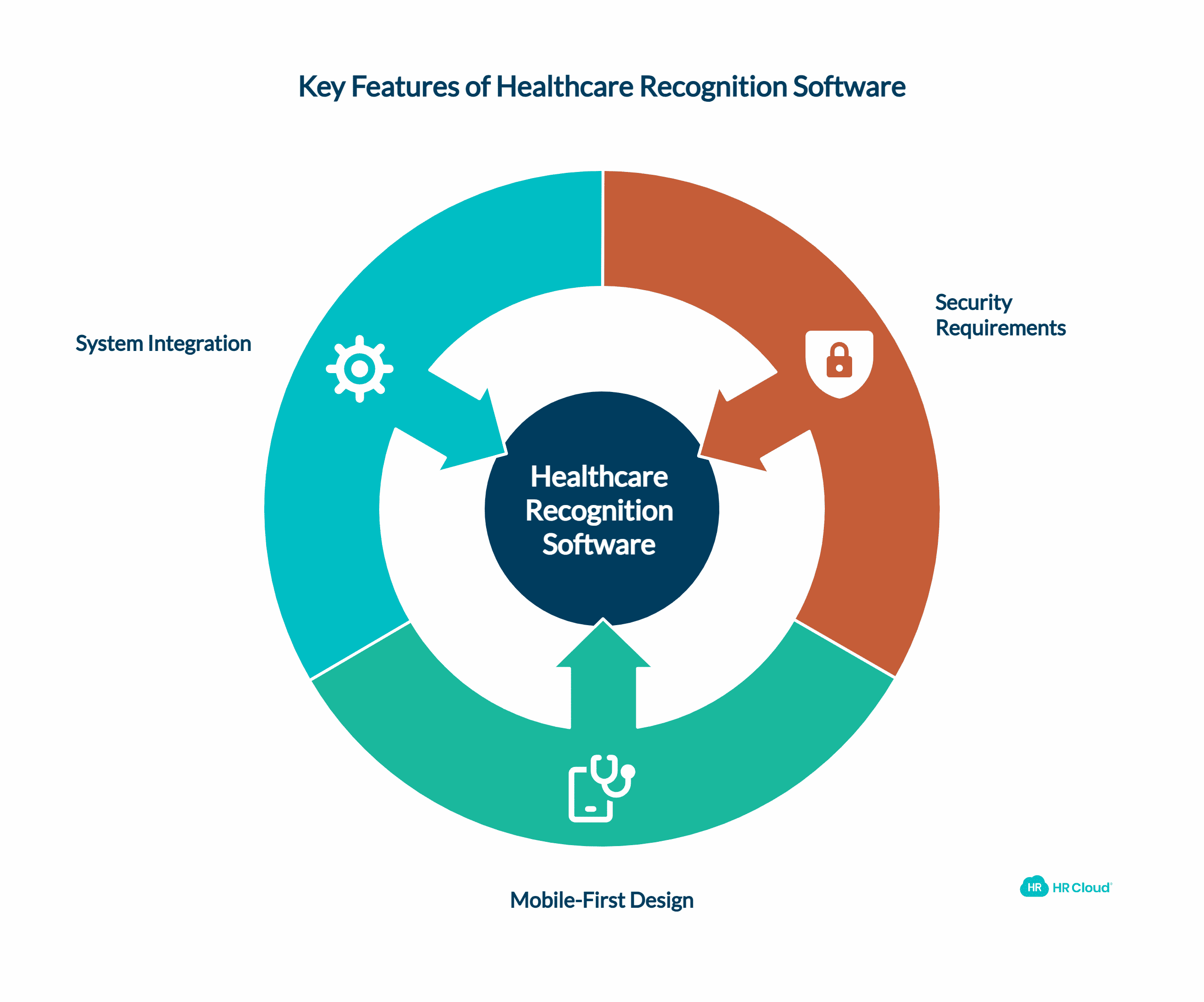
Not all employee recognition platforms work in healthcare settings. A solution designed for a tech startup won’t address the operational realities of hospitals and care networks. Healthcare teams need platforms that respect clinical workflows, protect workforce data, and integrate with the systems staff already use.
Security and Governance Requirements
Healthcare organizations operate in high-risk environments where security and auditability matter.
Essential controls for recognition systems include:
-
Audit trails & access logs to track actions for internal reviews.
-
Role-based access controls to limit who can view and do what.
-
Encryption in transit and at rest aligned to modern standards.
-
SOC 2 Type II–aligned practices and clear security documentation.
-
Configurable data retention and export controls for governance.
Important note: Recognition programs should avoid any patient information. Set clear guidelines so messages never include clinical details or identifiers.
HR Cloud supports these needs with enterprise-grade security, granular permissions, and comprehensive logging designed for workforce (employee) data.
Mobile-First Design for Frontline Workers
Here's the reality: the majority of healthcare workers barely touch computers during shifts. Floor nurses chart on mobile workstations but spend most time in patient rooms. CNAs move constantly between beds. Home health nurses drive between appointments. These frontline workers—representing 60-70% of healthcare employees—rarely sit at desks with traditional computers.
If your staff appreciation platform requires desktop access, you've automatically excluded the majority of your workforce from participating in peer recognition programs.
Essential mobile capabilities for nursing staff recognition and frontline employee engagement:
-
Native mobile apps with offline capability for areas with poor connectivity in hospitals and care facilities
-
Full functionality through mobile devices without requiring a desktop for any features or recognition activities
-
Quick, frictionless interactions taking less than 30 seconds to send employee kudos or team appreciation
-
Push notifications that respect clinical focus without disrupting patient care activities
HR Cloud's Workmates platform was built with a mobile-first design specifically for distributed and frontline workforces, enabling full recognition functionality from any smartphone for nurses, CNAs, therapists, and all healthcare staff.
Ready to see how recognition transforms healthcare culture? Schedule a demo to explore Workmates' mobile-first design and healthcare features.
Integration with Healthcare Systems
Healthcare organizations run on complex ecosystems of interconnected systems. Adding a recognition platform that sits in isolation creates another data silo and adoption barrier. The best employee recognition software for healthcare integrates seamlessly with existing hospital management systems, workforce scheduling tools, and communication platforms.
What integrations matter most for hospital recognition programs?
Valuable integrations for medical facility employee engagement include:
-
HRIS and payroll systems: HR Cloud integrates with ADP, UKG, and Paylocity, ensuring employee data stays synchronized automatically for accurate recognition delivery and reward distribution
-
Workforce management and scheduling: Understanding shift schedules enables targeted recognition for night shift workers, weekend staff, and on-call teams who often feel disconnected from daytime appreciation activities
-
Communication platforms: Integration with Teams or Slack meets staff where they collaborate, delivering recognition notifications through channels healthcare workers already check regularly
-
Learning management systems: Automatic celebration of training completions, continuing education credits, and certifications keeps clinical staff motivated to maintain credentials
-
Single Sign-On (SSO): Access using existing hospital credentials eliminates password fatigue and streamlines the login process for busy healthcare professionals
Why do healthcare organizations need automated milestone tracking?
Most industries track work anniversaries and completed projects. Healthcare adds complexity with compliance-driven milestones that generic employee appreciation platforms can't accommodate without extensive customization.
Healthcare organizations need nurse recognition software and staff appreciation tools that automatically celebrate:
-
License renewals for nurses, respiratory therapists, and other healthcare professionals maintaining state credentials
-
Certification achievements from basic life support to specialized credentials like CCRN, CEN, or oncology nursing certifications
-
Competency validations requiring annual or semi-annual revalidation for clinical procedures and protocols
-
Mandatory education completions for infection control updates, safety protocols, and other industry-specific training
-
Preceptor milestones for experienced staff training new employees, students, and residents
HR Cloud's Workmates supports automated milestone recognition configured for healthcare-specific achievements, automatically triggering celebration when employees complete certifications or reach career milestones without requiring manual tracking by HR departments.
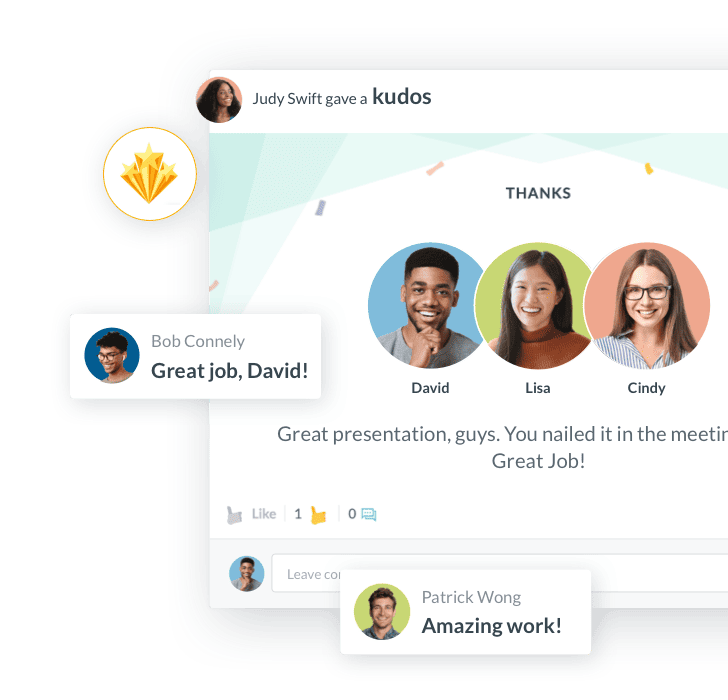
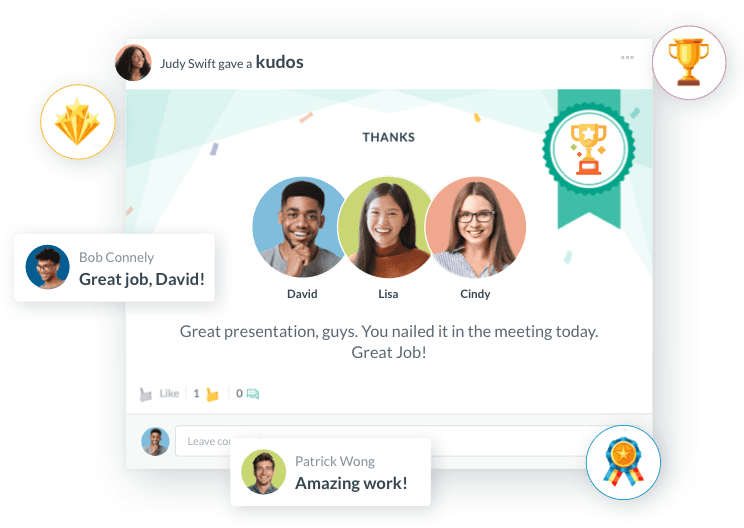
Which Recognition Platforms Lead the Healthcare Market in 2025?
The employee recognition software market has exploded, with dozens of vendors claiming perfection. But healthcare organizations need platforms built for medical environments, not generic engagement tools. When comparing recognition software for nurses, hospital staff appreciation systems, and healthcare employee rewards programs, specific criteria determine which solutions actually work in clinical settings versus which create more problems than they solve.
Platform Comparison: Healthcare Recognition Software Leaders
|
Platform |
Overall Rating |
Healthcare Features |
HIPAA/Security |
Mobile |
Implementation |
Key Strength |
Critical |
|
HR Cloud Workmates |
⭐⭐⭐ |
Shift recognition, automated milestones, healthcare analytics |
SOC 2, enterprise encryption, BAA-ready |
Native app with offline |
2-4 weeks |
Comprehensive platform with fast deployment |
Requires quote for pricing |
|
Bonusly |
⭐⭐⭐ (3.2/5) |
Minimal healthcare customization |
Basic security, no BAA |
Mobile-responsive web |
1-2 weeks |
Simple peer recognition |
No healthcare-specific features, limited analytics |
|
Kudos |
⭐⭐⭐⭐ (3.7/5) |
Values-based recognition |
Standard enterprise security |
Mobile-responsive |
2-3 weeks |
Culture-building tools |
Weak reporting, users complain about limited insights |
|
Workhuman |
⭐⭐⭐⭐ (3.9/5) |
Enterprise-scale capabilities |
Enterprise-grade security |
Full mobile app |
8-12 weeks |
Advanced analytics |
Painfully slow implementation, complex setup |
|
O.C. Tanner |
⭐⭐⭐ (3.4/5) |
Service awards focus |
Enterprise security |
Limited mobile |
6-10 weeks |
Traditional recognition |
Outdated interface, slow innovation cycle |
|
Awardco |
⭐⭐⭐⭐ (3.6/5) |
Extensive rewards catalog |
Standard security |
Mobile-responsive |
3-4 weeks |
Large Amazon rewards |
Recognition features underdeveloped vs rewards |
|
Nectar |
⭐⭐⭐ (3.3/5) |
Department-specific recognition |
Basic security |
Mobileapp |
2-3 weeks |
Budget-friendly |
Lacks enterprise features, limited support |
Why HR Cloud Workmates Dominates Healthcare Recognition
While several platforms offer quality features, HR Cloud's Workmates platform stands apart for healthcare organizations seeking comprehensive solutions rather than single-purpose recognition tools for hospitals and clinics.
Integrated Platform Beyond Basic Recognition
Most recognition platforms focus solely on peer-to-peer kudos. Workmates takes a broader approach, recognizing that employee engagement requires more than recognition—it demands comprehensive communication, collaboration, and culture-building unified in one platform for hospital employee engagement.
How does mobile accessibility improve frontline worker engagement?
Workmates combines recognition with an employee engagement platform, including:
-
Social intranet features maintaining connection across shifts for 24/7 healthcare operations and distributed nursing teams
-
Company-wide communications reaching all staff regardless of computer access, shift schedules, or department locations
-
Pulse surveys identifying engagement risks before turnover, measuring nurse satisfaction, and tracking staff morale
-
Organizational charts and directories for quickly finding colleagues across departments and care units
This integrated approach solves a critical challenge: tool proliferation. Rather than separate systems for recognition, communications, surveys, and collaboration, Workmates consolidates everything into one cohesive experience for healthcare workforce management.
Mobile Experience Built for Healthcare
HR Cloud delivers with a native mobile application designed specifically for frontline workers. The app provides full recognition functionality—sending kudos, browsing feeds, viewing rewards, participating in social features—all optimized for smartphones used by nurses, CNAs, therapists, and all healthcare staff on the go.
Critically, the mobile experience includes offline capability. Nurses in areas with spotty connectivity can compose recognition messages that automatically sync when network access returns. This practical feature makes enormous difference in real-world hospital environments where WiFi coverage remains inconsistent across buildings and care units.
Implementation Speed That Crushes Competitors
Healthcare organizations operate 24/7/365 with limited bandwidth for lengthy software deployments. HR Cloud positions implementation at 2-4 weeks—dramatically faster than enterprise platforms requiring 8-12 weeks or longer for employee recognition system setup.
The platform achieves this speed through:
-
Pre-built healthcare templates eliminating starting from scratch with recognition categories, values, and workflows
-
Streamlined data migration via integrations with ADP, UKG, and other HRIS platforms used by hospitals and health systems
-
Role-based training materials targeted to different user types from frontline nursing staff to department managers
-
Dedicated implementation support ensuring correct configuration for healthcare-specific requirements
Competitors like Workhuman require months of implementation, creating change fatigue before programs even launch. O.C. Tanner's 6-10 week timeline delays ROI significantly compared to Workmates' rapid deployment.
Healthcare-Specific Analytics
Recognition without measurement is just feel-good activity. Workmates provides analytics designed for healthcare decision-makers:
-
Department-level participation tracking identifying which units need intervention for better staff appreciation
-
Shift-based recognition patterns ensuring night shift workers receive equivalent recognition to day shift teams
-
Manager engagement metrics tracking which nursing leaders actively recognize teams versus those needing coaching
-
Recognition-to-retention correlation quantifying program ROI for CFO presentations and budget justification
-
Values alignment reporting showing which organizational values get reinforced through peer recognition activities
HR Cloud claims that Workmates can increase retention by 30% through its recognition and engagement capabilities—a game-changing impact for organizations hemorrhaging millions in turnover costs annually.
Curious about implementing recognition that fits healthcare's unique needs? Schedule a consultation to explore how Workmates addresses your facility's challenges.
Competitor Limitations Based on User Reviews
Bonusly: Users consistently report frustration with limited analytics and lack of healthcare-specific features. The platform works for simple peer recognition but falls short for organizations needing robust reporting or compliance capabilities.
Workhuman: While feature-rich, users complain about painfully slow implementation timelines and complexity that overwhelms healthcare staff already drowning in technology. The 8-12 week deployment creates enormous change management challenges.
O.C. Tanner: Reviews highlight outdated interfaces and slow innovation cycles. Healthcare organizations seeking modern, mobile-first experiences find O.C. Tanner disappointing compared to contemporary platforms.
Awardco: Users note that recognition features lag far behind the rewards catalog. Organizations wanting sophisticated recognition workflows and analytics find Awardco's capabilities underdeveloped.
ROI Healthcare Organizations Should Expect from Recognition Software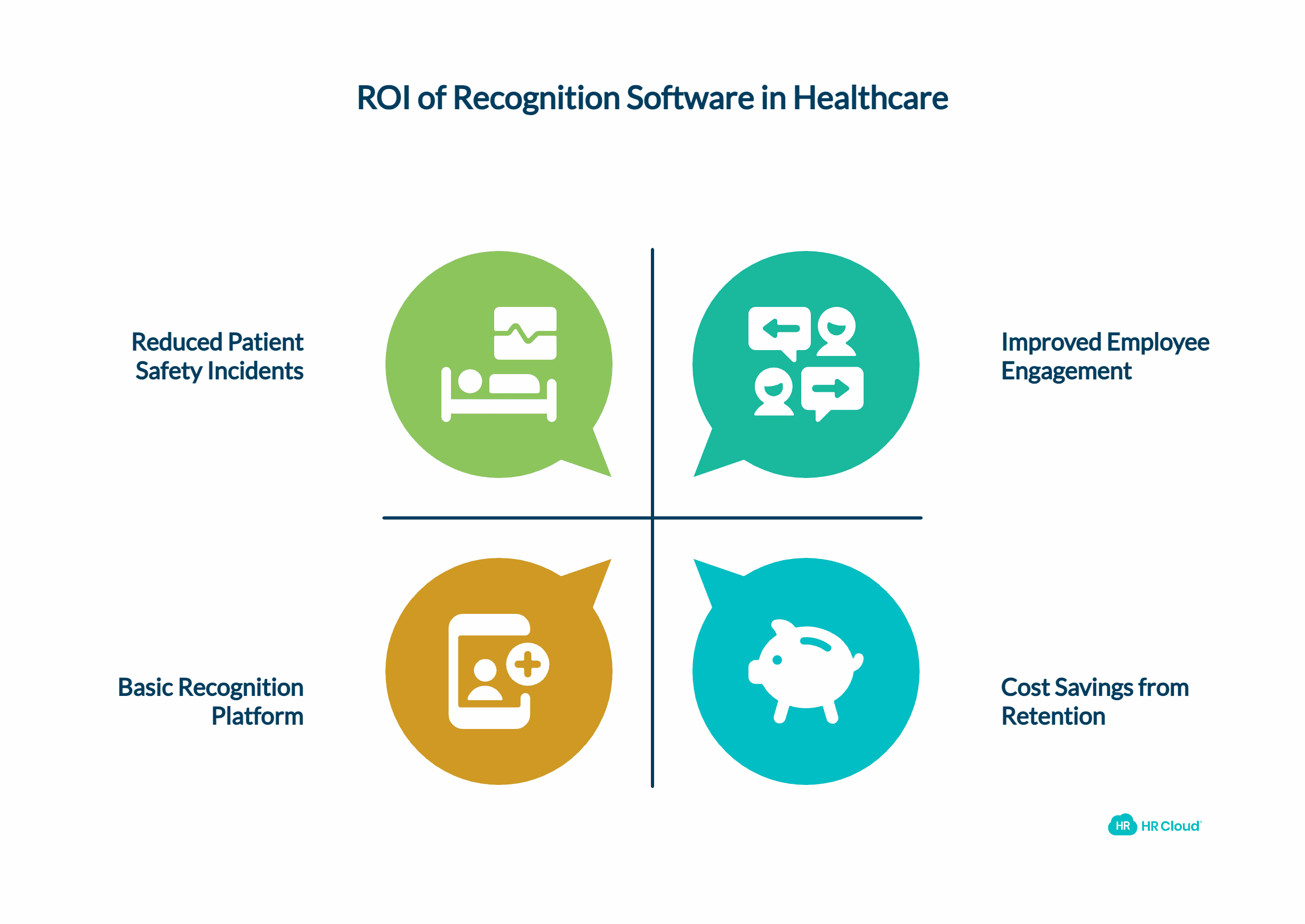
Healthcare CFOs demand evidence that recognition software investments generate tangible returns. Let's examine quantifiable impacts.
Direct Cost Savings from Improved Retention
Scenario: 300-bed hospital
Before Recognition Software:
-
500 clinical and support staff
-
18% annual turnover = 90 departures
-
$50,000 average replacement cost
-
Annual turnover expense: $4,500,000
After 12 Months with Recognition:
-
31% reduction in voluntary turnover = 14.4% new rate
-
72 annual departures
-
Annual turnover expense: $3,600,000
-
Annual savings: $900,000
Program Costs:
-
Platform subscription: ~$75,000 annually
-
Rewards budget: $100,000 annually
-
Implementation: $25,000 (one-time)
-
Net First-Year ROI: $700,000
Measuring Indirect Benefits
Financial models focused solely on turnover reduction underestimate recognition program value. Beyond direct cost savings, healthcare organizations experience multiple compounding benefits that strengthen both financial performance and clinical outcomes.
Improved Employee Engagement
Employee engagement transforms organizational performance in measurable ways. Organizations with high employee engagement achieve 23% higher profitability, a metric that translates to operational efficiency and resource utilization in healthcare settings.
Key engagement impacts include:
-
23% higher profitability in highly engaged organizations
-
Better patient experiences and clinical outcomes from engaged staff
-
Improved efficiency in daily operations and resource allocation
-
Stronger teamwork and interdepartmental collaboration
Reduced Patient Safety Incidents
Patient safety represents perhaps the most critical indirect benefit of healthcare employee recognition programs. Healthcare organizations with highly engaged employees experience 41% fewer patient safety incidents—a staggering improvement that saves lives while protecting organizational reputation.
Safety improvements deliver:
-
41% fewer patient safety incidents with engaged workforces
-
Reduced sentinel events saving direct incident response costs
-
Prevention of incalculable reputational damage from safety failures
-
Lower litigation exposure from medical errors and adverse events
Lower Absenteeism
Highly engaged organizations report 78% lower absenteeism compared to disengaged workplaces. In healthcare, where unplanned absences create immediate staffing crises, reduced callouts translate to significant operational savings.
Absenteeism reduction benefits:
-
78% lower absenteeism in organizations with strong engagement
-
Fewer premium-pay shifts covering unexpected callouts
-
Reduced reliance on expensive emergency staffing agencies
-
Better continuity of care for patients with consistent nursing teams
Faster New Hire Productivity
Engaged teams onboard new colleagues more effectively through welcoming cultures and better knowledge transfer. This acceleration in time-to-productivity reduces the productivity loss period that makes new hire costs so expensive for healthcare organizations struggling with constant turnover.
Enhanced Talent Attraction
Healthcare organizations known for strong cultures and employee appreciation enjoy recruiting advantages in competitive labor markets. Reducing time-to-fill for vacant positions saves both direct recruiting costs and lost productivity from understaffing during extended vacancies.
Key Performance Indicators to Track
Understanding which metrics matter most helps healthcare organizations measure employee recognition program effectiveness and demonstrate value to leadership. These indicators separate successful recognition initiatives from underperforming programs that drain budgets without delivering results.
Adoption Metrics
Track whether your workforce actually uses the recognition platform you've invested in. These foundational metrics reveal participation levels:
-
Percentage of employees registered and actively using the staff appreciation platform each month
-
Average recognition messages per employee per month (target at least 2-3 for meaningful culture change)
-
Manager participation rate showing leadership engagement in peer recognition programs
-
Recognition distribution across departments, shifts, and roles to identify gaps
Engagement Indicators
Connect recognition activities to broader workforce sentiment. Employee engagement survey scores provide quantitative measures of how staff feel about their work environment. Employee Net Promoter Score (eNPS) asks the ultimate question: would your staff recommend your healthcare facility as a great place to work?
Key engagement measurements include:
-
Overall employee engagement survey scores tracking culture improvements
-
Recognition-specific questions measuring whether employees feel appreciated
-
Participation rates in company events and voluntary initiatives
-
Internal communication engagement and social feed activity
Retention Outcomes
Deliver the bottom-line proof that recognition programs generate ROI. Overall turnover rate compared to baseline and industry benchmarks shows whether your employee retention strategies are working.
Critical retention metrics to monitor:
-
Overall voluntary turnover rate compared to pre-implementation baseline
-
Turnover breakdown by department, shift pattern, and tenure cohort
-
Exit interview themes revealing whether lack of appreciation drives departures
-
New hire retention rates during critical first 90 days and first year
-
Comparison to healthcare industry turnover benchmarks
Financial Impact
Translate soft engagement initiatives into hard numbers that CFOs and hospital executives understand. Calculate turnover cost savings comparing pre- and post-implementation expenses. Track recruitment cost trends to see whether improved retention reduces reliance on expensive hiring campaigns.
Monitor these financial indicators:
-
Turnover cost savings using replacement cost calculations
-
Recruitment and hiring expense trends over time
-
Agency and premium staffing costs for emergency coverage
-
Time-to-fill for vacant positions showing improved employer reputation
-
Overall HR budget efficiency improvements
HR Cloud's Workmates analytics provide these workforce engagement metrics automatically without manual data compilation, saving HR teams countless hours while delivering the insights needed to optimize recognition program performance and prove value to organizational leadership.
Implementation Strategy for Healthcare Environments
Buying the right platform represents half the battle. Implementation determines whether your investment generates returns or becomes unused technology gathering digital dust.
Weeks 1-2: Foundation and Pilot Planning
-
Assemble implementation team with HR, IT, clinical leadership, frontline staff
-
Define success metrics before launch
-
Select 2-3 pilot departments with supportive managers and measurable challenges
-
Customize platform configuration with healthcare-specific recognition values
Weeks 3-4: Manager Training and Pilot Launch
-
Train managers first on why recognition matters and platform mechanics
-
Create launch events generating excitement through department meetings
-
Enable gradual staff access in waves preventing overwhelm
-
Monitor technical issues aggressively ensuring smooth experience
Weeks 5-8: Momentum Building
-
Celebrate early wins publicly sharing recognition stories organization-wide
-
Collect feedback systematically using Workmates' pulse survey capabilities
-
Adjust based on insights creating shift-specific guides if needed
-
Train expansion wave leaders using pilot participants as guest speakers
Weeks 9-12: Organizational Expansion
-
Launch additional departments at 3-5 per week
-
Create recognition champions providing peer support
-
Integrate into existing workflows adding to shift huddles and meetings
-
Address low-adopting departments with focused interventions
Healthcare-Specific Considerations
-
Shift-based communication ensuring all shifts receive information
-
Union environments involving leadership early
-
Multilingual workforces accommodating linguistic diversity
-
High-turnover positions building recognition into new hire onboarding
Ready to implement a program that drives retention? Connect with HR Cloud's specialists for implementation strategies tailored to your facility.
Conclusion: Choose Recognition Software That Actually Works in Healthcare
Healthcare in 2025 operates under extraordinary pressures. Turnover costs the average hospital $6.6-$10.5 million annually. Staff shortages persist across most markets. Patient expectations continue rising. And every clinical leader understands retention problems threaten patient care quality and organizational sustainability.
Employee recognition software won't solve every challenge your healthcare organization faces. It won't compensate for inadequate staffing ratios, toxic management practices, or non-competitive compensation packages. But when implemented thoughtfully as part of a comprehensive workforce retention strategy, recognition platforms generate measurable returns through reduced turnover, improved engagement, and stronger organizational culture.
HR Cloud's Workmates platform represents the strongest choice for healthcare organizations based on comprehensive features, healthcare-specific design, proven integrations with hospital systems, and 2-4 week implementation crushing competitors requiring months of deployment time. The platform combines staff recognition with broader engagement and communication tools, reducing tool proliferation while addressing the full spectrum of employee experience needs from onboarding through retention.
Success requires strategic planning. Start with internal assessment of current recognition practices, retention challenges, technology infrastructure, and organizational readiness for culture change. Involve stakeholders early—clinical leadership, HR teams, IT departments, and frontline staff representatives. Prioritize pilot approaches with 2-3 departments before organization-wide deployment to validate effectiveness and identify implementation issues. Plan for long-term success with governance processes, champion identification, and continuous improvement mechanisms that sustain recognition culture beyond initial launch excitement.
The best employee recognition software for healthcare organizations delivers mobile-first design for frontline workers, robust security features tailored for medical environments, seamless integration with existing hospital systems, and analytics proving ROI to executive leadership. These capabilities distinguish platforms built for healthcare from generic employee engagement tools that can create more problems than they solve in complex medical settings.
Ready to transform your healthcare organization's retention and culture? Schedule a demo with HR Cloud to see Workmates' healthcare-specific capabilities and discuss your unique challenges with recognition specialists who understand medical facility operations.
Frequently Asked Questions
Can recognition software comply with HIPAA in hospitals?
Yes, employee recognition platforms can be securely configured to meet the compliance needs of healthcare environments. Recognition platforms don't typically handle patient health information (PHI) directly but operate within healthcare IT environments where PHI exists. Compliance requires encryption standards (TLS 1.2+, AES-256), comprehensive audit logging, role-based access controls, and Business Associate Agreements. Organizations should implement policies preventing PHI in recognition messages—avoid "Great job treating the patient in Room 312" and instead say "Great job demonstrating clinical excellence today." Healthcare organizations should verify vendors maintain SOC 2 Type II certification and healthcare experience before purchasing staff recognition software.
How long does Workmates implementation take for a 500-bed hospital?
HR Cloud positions Workmates implementation at 2-4 weeks for most healthcare organizations—dramatically faster than competitors requiring 8-12 weeks for employee engagement software deployment. Actual timeline depends on HRIS integration complexity and customizations needed for your specific hospital recognition program. A 500-bed hospital with straightforward ADP or UKG integration could complete implementation in 2-3 weeks, getting nurse appreciation programs up and running quickly. Organizations requiring custom integrations with legacy systems might extend to 4-5 weeks—still significantly faster than alternatives that delay ROI for months.
Does Workmates integrate with UKG workforce scheduling?
Yes, HR Cloud supports UKG integrations for workforce management and employee scheduling systems. This integration matters because it enables recognition platforms to understand shift schedules, department assignments, and workforce structure automatically without manual data entry. Organizations should verify during sales discussions whether the integration covers their specific UKG product (UKG Pro, UKG Ready, UKG Dimensions) and whether custom development work is needed for healthcare-specific scheduling requirements.
How much can recognition reduce nurse turnover?
Studies show 31% lower voluntary turnover with effective employee recognition programs in healthcare settings. Gallup research demonstrates well-recognized employees are 45% less likely to leave after two years. HR Cloud claims Workmates increases retention by 30% through its comprehensive recognition and engagement capabilities. Realistic expectations for healthcare organizations implementing nurse recognition software alongside other retention strategies: 15-25% reductions in voluntary turnover within 12-18 months when recognition complements competitive compensation and respectful leadership.
What mobile capabilities do platforms need for frontline staff?
Essential capabilities for healthcare employee recognition apps include native mobile applications (not just responsive websites) for iOS and Android devices, full functionality without desktop dependency for nurse recognition and staff appreciation, offline capability with automatic sync for areas with poor hospital WiFi, push notifications respecting clinical focus, and quick interactions taking under 30 seconds to send employee kudos. HR Cloud's Workmates delivers these requirements with mobile-first design specifically for distributed and frontline workforces including nurses, CNAs, therapists, and all healthcare staff who spend minimal time at computers.
What metrics matter most for measuring program success?
Track leading indicators including platform adoption rate, recognition frequency per employee, and manager participation monthly to predict future success of your healthcare recognition program. Monitor lagging indicators including voluntary turnover rate, employee engagement survey scores, and exit interview themes quarterly to measure actual retention outcomes. The sophisticated approach correlates leading and lagging indicators to identify whether recognition engagement predicts retention improvements and reduced nurse turnover. Organizations with Workmates' advanced analytics track these workforce engagement metrics automatically without manual analysis, saving HR teams time while proving program value to hospital leadership.

Keep Reading
Why Workmates by HR Cloud Stands Out: Best Recognition Tool to Drive Employee Motivation
Workmates by HR Cloud delivers comprehensive peer-to-peer recognition through
Giant List of 100+ Employee Recognition Message Templates (Just Copy & Paste)
"Great job!" is the workplace equivalent of "We need to talk" — vague and unhelpful. And
Best Peer-to-Peer Recognition Software & Kudos Platforms (2025 Buyer's Guide)
Picture this: A manufacturing team in Ohio just hit their monthly safety record. In the
Like What You Hear?
We'd love to chat with you more about how HR Cloud® can support your business's HR needs. Book Your Free Demo

Build a Culture of Recognition. Boost Engagement. Guaranteed.
Workmates empowers employees to stay informed, connected, and appreciated—whether they’re on the front line, in the office, or remote. Recognition drives 12x higher engagement.Trusted by industry leaders in every sector




Cut Onboarding Costs by 60%.
Take the confusion and follow-ups out of onboarding with automated workflows, digital forms, and structured portals—so new hires ramp faster 3X quicker.Trusted by industry leaders in every sector




